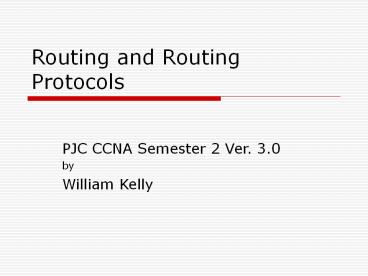Routing and Routing Protocols - PowerPoint PPT Presentation
Title: Routing and Routing Protocols
1
Routing and Routing Protocols
- PJC CCNA Semester 2 Ver. 3.0
- by
- William Kelly
2
Routing Basics
- Routing is the process of forwarding packets from
a source to a destination based on the
destination IP address of the packet - Routing occurs at layer 3 of the OSI model
(network layer) - Routes can be entered by the administrator
(static) or learned from other routers (dynamic) - The network layer provides a best-effort
delivery system - The router uses a routing table to send packets
from a source to a destination
3
How Routers Route Packets
- Consistent end-to-end Network addressing is the
key to routing - Broadcasts are minimized and bandwidth is
conserved
4
The 2 Functions of a Router
- Best Path Determination The router determines
the best path to a destination by examining the
Network portion of an address and consulting its
routing tables (a map of the network contained in
each router) - Switching A router accepts a packet on one
interface and forwards it to another interface
5
Routed vs. Routing Protocols
- Routed protocols are network protocols that
provide enough information for a packet to be
forwarded from one host to another - Routing protocols allow routers to communicate
information about network paths and to maintain
tables
6
Routed vs. Routing Protocols
- Routed protocols are network protocols that
provide enough information for a packet to be
forwarded from one host to another - Routed protocols allow routers to communicate
information about network paths and to maintain
tables
7
Common Routed and Routing Protocols
- Routed Protocols
- IP
- IPX
- Appletalk
- Routing Protocols
- RIP
- IGRP
- OSPF
- EIGRP
- BGP
8
Static Routing
- Routing instructions manually entered by an
administrator - Routes must be changed manually when the network
topology changes - Static routing is labor intensive
- Static routes are used to enhance security and to
set up routes accessible by only one path
9
Network Layer Protocols
10
Configuring a Static Route
- Syntax for entering a static route using the
interface - Router(config) ip route 192.168.2.0
255.255.255.0 S1 - Syntax for entering a static route using the
next hop addressRouter(config) ip route
192.168.2.0 255.255.255.0 192.168.1.2 - Syntax for entering a default route (sometimes
called a quad route) - Router(config) ip route 0.0.0.0 0.0.0.0 S1
- Syntax for entering a quad route with an
administrative distance - Router(config) ip route 0.0.0.0 0.0.0.0
192.168.1.2 4
11
Examining Static Route Syntax
- Syntax for entering a static route using the
interface - Router(config) ip route 192.168.2.0
255.255.255.0 S1
Syntax for entering a static route using the
interface Router(config) ip route 192.168.2.0
255.255.255.0 192.168.1.2
12
Common Administrative Distances
13
Application of Administrative distances in Static
Routes
- When using a next hop address the default
administrative distance is 1 - When using an outgoing interface the default
administrative distance is 0
14
Dynamic Routing
- Dynamic routing allows routers to automatically
share routing (topology) information with other
routers
15
Routing Protocols
- RIP distance vector protocol, metric is hop
count, max hop count is 15, updates every 30
seconds - IGRP distance vector protocol, metric is
bandwidth, delay, load, and reliability, highly
scalable for large networks, updates every 90
seconds - OSPF link state protocol, uses triggered
updates, VLSM compliant - EIGRP Cisco proprietary hybrid protocol, VLSM
compliant - BGP exterior routing protocol that was designed
to work between ISPs
16
Commonly Used Metrics
- Bandwidth data capacity of a link
- Delay length of time for a packet to travel
through links - Load amount of network activity
- Reliability error rate
- Hop Count number of routers a packet must
traverse - Ticks each tick is 1/18 of a second
- Cost
17
Link State Basics
- Link State Protocols use the Link State Algorithm
(also called the Dijkstras algorithm) - Link State Advertisements (LSAs) are transferred
between routers to provide topology information - Each router maintains a topology database of LSA
information - The Dijkstras algorithm computes the shortest
paths to different networks - The routing table is then populated with the best
paths
18
Link State Concerns
- Processor Overhead
- Memory requirements
- Bandwidth consumption The initial discovery
process is bandwidth intensive thereafter,
minimal bandwidth is required
19
Hybrid Routing Protocols
- Similar to distance vector protocols in that
metrics are used but the metrics are more
accurate. - Similar to Link State protocols in that triggered
updates are used instead of period updates - Examples are IS-IS and EIGRP
20
Configuring a Router to Use Routing Protocols
- Starting routing
- Router(config) router protocol options
- ex Router(config) router rip
- Entering Networks
- Router(config) network network-number
- ex Router(config) network 192.168.1.0
- Note A separate network line must be used to
enter every network whose interface will
participate in the sending and receiving of
routing updates
21
Autonomous Systems
- Interior Gateway Protocols (IGP) were designed to
be used in a network designed to be administered
by a single organization - Exterior Gateway Protocols (EGP) were designed to
be used between networks that are controlled by
two organizations. EGPs such as BGP are used
between ISPs - Every autonomous system is assigned a 16 bit
identifying number by the American Registry of
Internet Numbers (ARIN)































